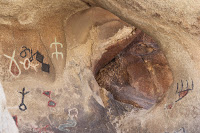Bombay Run, Feb. 9, 2012
We're not up and at 'em early. But it is cool, so if we don't get out and about until 9 a.m. I'm way okay with that. We got on the road and went to breakfast at a nice little cafe located next to the Joshua Tree Park Visitor Center. The coffee and food were good, and we were on our way, back into Joshua Tree Park. This time the intent was to stop a lot, hike a bit and take lots of photos. That was the mission of this trip.
 |
| Photographer at work. |
The first stop was just to photograph the Joshua trees. While photographing, I caught a photographer in her natural work element, starting photos for her blog of the day, “The Ottoman Trail.”
 |
| Joshua trees at the Quail Springs picnic area. We did not picnic here. We were on the photography time clock. |
Joshuas are considered the trees of life. Almost every part of the tree can be used by either humans or animals. Even after death the tree trunk can provide a home for lizards, ants and scorpions. Eventually termites return the tree to the desert enriching the soil for the next Joshua tree sprout.
 |
| You can nearly see me next to the tall Joshua with beautiful rock formations in the background. |
Joshuas grow at elevations of 2,000 to 6,000 foot levels, in California, Nevada, Arizona and Utah. I've seen them in Arizona and California for sure. In fact I came up the highway and through the Joshuas as I rode to meet Jaz.
The name Joshua tree was given by a group of Mormom settlers who crossed the Mojave Desert in the mid-19th century. The tree's unique shape reminded them of abiblical story in which Joshua reaches his hands up to the sky in prayer. Ranchers and miners used the trunks and branches as fencing and for fuel for ore-processing steam engines. The tree can live for hundreds of years and grow to a height of 49 feet.
 |
| This is the first photo of me using the timer on my camera. The background is a juniper bush. The berries are bitter, but I read that the animals don't seem to mind and seek them out to eat. |
 |
| I couldn't help but take this photo with the shadow of the Joshua tree and me, and up in the right hand corner a little piece of Jaz. |
We chose to hike in to Barker Dam. The original stone dam was built around 1900, but the piece on which I'm standing was built in 1949-50.
 |
| Standing on Barker Dam. |
When looking at it from the lower side, it appears there was a rock dam built, and additions made to it later on.
 |
| The writing on the dam wall. |
 |
| The dam is on the left and the right side shows where the water would come down between huge rocks. |
 |
| Jaz in front of the dam, and where we'd have to run for high ground if it started to rain. |
You can see how high it is now. It is fed by rain but when we were here, it was completely dry. We knew if it started to rain there'd probably be flash flooding and we'd need to run for higher ground. That didn't happen, and the temperature for the day kept rising, until eventually it was 85 degrees, perfect riding weather. I even got to do a little riding in a T-shirt today. Oh yes, it felt so good.
 |
| The small dam appears to be an animal watering hole. There was a trail around the hole that was smooth and seemed to be where animals circled around to drink. |
 |
| Petroglyphs were a part of the Barker Dam trail and were up above inside a rock formation. |
 |
| Just little pods, no blossoms. |
From the dam hike, we wandered on down to the cholla cactus garden. The garden is mostly jumping cholla, named because of the tendency to attach itself to the unwary. As we came down out of the hills we could see the chollas stretching for miles. It was a sight to see.
We'd been told if there were any blossoms it would be here, but there was nothing, nada. A hike around the garden yielded photos of the cactus, the pods where blossoms might have been, and darkened plants that appeared to have been burned. The true story is that they were dead parts of the plants, but the rest continued to grow on some of them. The needles were long, and deadly. The plants themselves looked rather fuzzy, and were a beautiful sight … from a distance, of course.
 |
| The cholla varies in color because some is dead or dying, some is alive and well. The plant looks to be fuzzy and welcoming. It is not, and viewers should not be fooled. |
We came out of the park and headed toward Mecca, thinking we'd get a hotel there for the night. There was a lot of agricultural – potatoes, peppers, grapes, lettuce. It was really fun to see. The grapes intrigued me as they were wound around little tripod looking things. It appeared there might be barbed wire over them, perhaps to keep birds and other riffraff out? I don't know, and we didn't stop. We arrived in the little town, but it didn't appear to be a place for us to stay, so we wandered down the road to Indio. We found a nice little motel, and unloaded, went to have dinner, walked around a bit more, and headed for the barn for the night.
At that point it was time to blog!!!

No comments:
Post a Comment